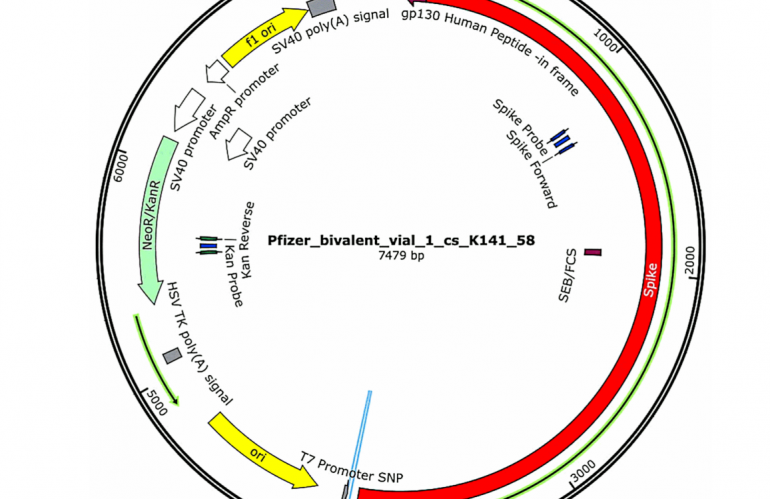In Depth
COVID-19 mRNA vaccines contain excessive quantities of bacterial DNA: evidence and implications
Michael Palmer, MD and Jonathan Gilthorpe, PhD
Recent studies by Kevin McKernan, a leading expert in sequencing methods for DNA and RNA, have revealed that batches of the modified mRNA vaccines produced by both Pfizer and Moderna contain a high proportion of contaminating bacterial DNA. In all, the DNA accounts for up to 20-35% of the nucleic acids contained in each of the vaccine batches. These alarmingly high concentrations far exceed the levels deemed safe by standard-setting organizations such as the European Medicines Agency (EMA). This document summarizes the evidence of that DNA contamination and discusses what possible health risks it implies to the recipients of the vaccines.
1. The role of DNA in the manufacture of mRNA vaccines
1.1. General background
Most readers will be aware that
- the synthetic RNAs contained in the COVID-19 mRNA vaccines encode the SARS-CoV-2 spike protein;
- in living mammalian cells, the instructions for building a given protein molecule are stored as a gene within the DNA inside the nucleus;
- to build a given protein molecule, the cell first transcribes its gene into RNA and modifies the two ends of this molecule to form messenger RNA (mRNA). The mRNA is then transported from the nucleus to the cytoplasm, where it induces the cell’s protein factories—the ribosomes—to translate the mRNA’s nucleotide sequence into the corresponding amino acid sequence and assemble the protein.
1.2. Steps in the manufacture of mRNA vaccines
Since the spike protein is a large molecule, so is the mRNA which encodes it. The total chemical synthesis of large mRNA molecules is not practical at scale. Therefore, in order to obtain the mRNA molecule encoding spike, the process by which cells produce their own mRNAs is mimicked in vitro. This involves the following steps:
- A DNA copy of the gene for the spike protein is inserted into a bacterial plasmid. This is a ring-shaped, double-stranded DNA molecule which can exist in a bacterial cell independently of the cell’s own chromosomal DNA, and which can also be copied and passed on to both daughter cells when that cell divides.
- The recombinant (artificial) plasmid carrying the spike protein gene is introduced into a cell of the bacterial species Escherichia coli (E. coli ). Since E. coli cells divide very rapidly, this one cell can within a short time be grown up to a very large number of cells. Each of these progeny cells will contain their own inherited copies of the plasmid, and therefore of the spike protein gene.While there is a certain chance of the plasmid being lost from some of the offspring during successive cell divisions, we can enforce its maintenance by giving it a selectable marker, which ensures that only those cells which retain the plasmid will survive. With the plasmids used by both Pfizer and Moderna, this selection marker is a gene which endows the host cells with resistance to the antibiotic kanamycin. To apply the selection, the bacteria are simply grown in the presence of kanamycin.
- After growing up a sufficient number of bacterial cells in a nutrient broth containing kanamycin, these cells are broken up and the plasmid DNA is purified from the other bacterial cell components.
- The ring-shaped plasmid molecules are converted to linear form using a restriction enzyme, which cleaves both strands of the DNA molecule at a specific, unique site which is located downstream of the spike protein gene. This step is needed to prevent the formation of RNA molecules that are overly long and might have undesired effects in vivo.The linearized DNA molecules can be purified from remaining circular ones, but in what manner and how efficiently this may be done in the production of Pfizer’s and Moderna’s vaccines is not public knowledge.
- An RNA polymerase is used, in the presence of the necessary nucleoside building blocks and cofactors, to copy the spike protein gene from the DNA version on the linearized plasmid into the mRNA version. Both Pfizer and Moderna employ the T7 RNA polymerase, which is derived from the eponymous bacteriophage. This enzyme binds to a cognate promoter sequence likewise derived from T7 that has been engineered into the plasmid upstream of the gene for the spike protein. This interaction between polymerase and promoter initiates the transcription.At this stage, the synthetic nucleoside N-methyl-pseudouridine (mψU) is incorporated into the artificial RNA instead of the natural uridine nucleoside. When delivered in the form of a vaccine, RNA modified in this manner is less stimulatory to the innate immune system than is RNA containing the natural uridine. It is also more efficiently translated into protein, and under certain conditions more resistant to degradation [1]. Both Pfizer’s and Moderna’s mRNA vaccines contain mψU instead of uridine.
- The two ends of each RNA molecule are coupled enzymatically to certain moieties that are also found at these positions within natural mammalian mRNAs, and which enhance its biological activity and stability in vivo.
Continue reading at: https://doctors4covidethics.org/covid-19-mrna-vaccines-contain-excessive-quantities-of-bacterial-dna-evidence-and-implications/
___
PDF version: https://doctors4covidethics.org/wp-content/uploads/2023/04/dna-contamination5.pdf


